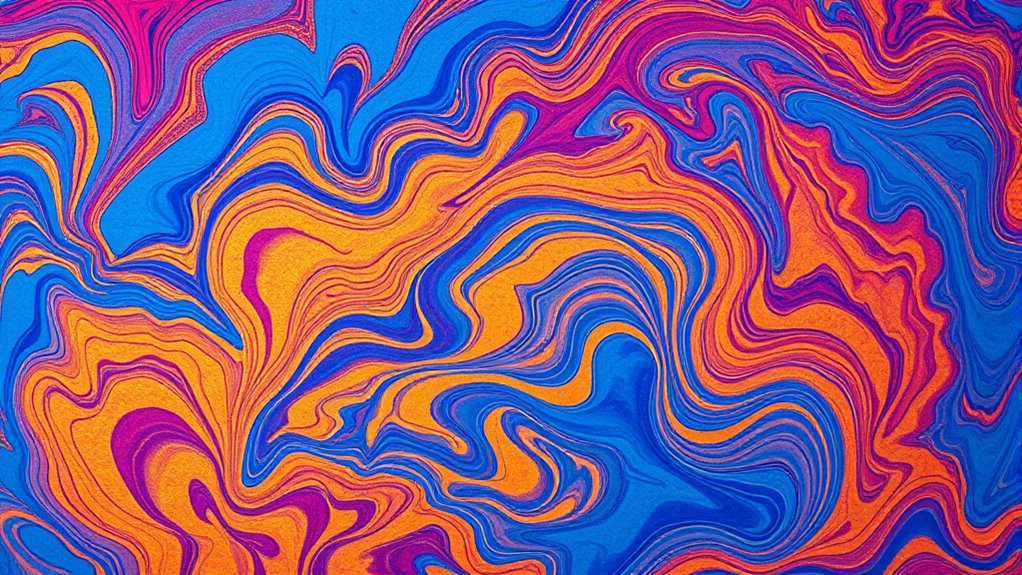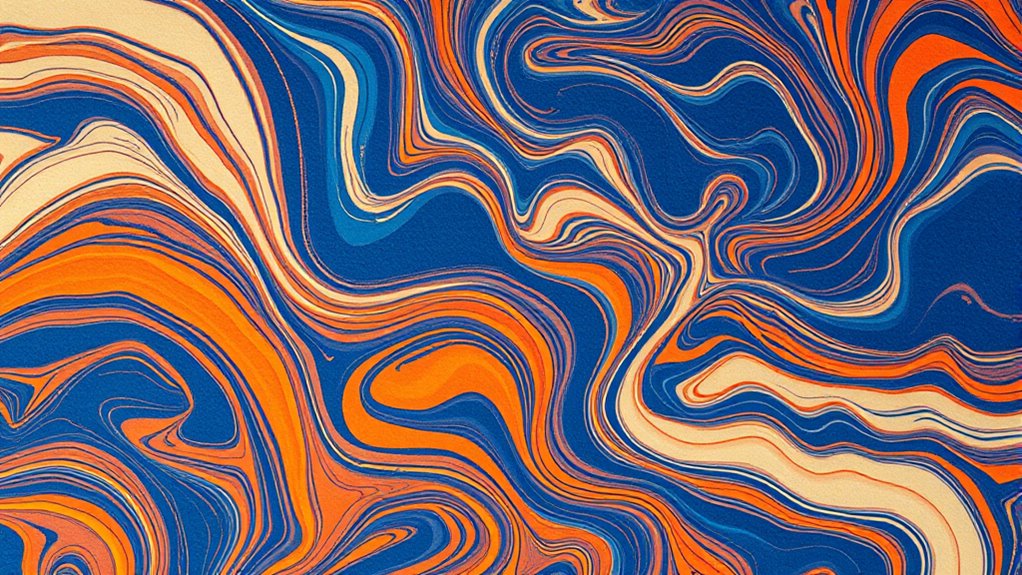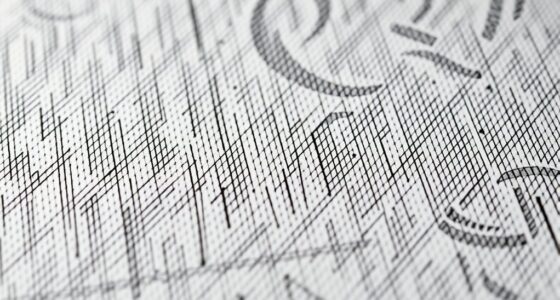To create swirling patterns in paper marbling, you carefully manipulate inks or dyes on a liquid surface, controlling how they diffuse and spread. You can use tools like combs or styluses to guide the ink’s organic movement, forming mesmerizing designs. Factors like surface tension, temperature, and ink composition influence the patterns you produce. Understanding these physical behaviors helps you craft intricate and harmonious swirls. Keep exploring to discover the full techniques behind this enthralling art form.
Key Takeaways
- Drop inks onto a viscous surface to initiate diffusion, enabling organic swirling patterns.
- Manipulate the ink with tools like combs or styluses to shape and enhance the swirling effects.
- Control variables such as surface tension, temperature, and ink composition to influence diffusion behavior.
- Use traditional techniques from East Asia and the Middle East, emphasizing understanding ink movement physics.
- Skilled artists anticipate and guide ink diffusion to create intricate, harmonious swirling designs.

Have you ever wondered how artists create those mesmerizing, swirling patterns on paper? The secret lies in a fascinating process called paper marbling, which involves manipulating inks and paints to produce intricate, flowing designs. At the heart of this technique is ink diffusion, a phenomenon where ink spreads out and interacts with the water or other mediums used. By understanding how ink diffuses across a liquid surface, artists can control the formation of their swirling patterns. Historically, these techniques date back centuries, originating in East Asia and the Middle East, where craftsmen developed methods to produce beautiful, decorative paper for calligraphy, bookbinding, and art. These traditional techniques relied heavily on natural materials and a keen eye for the way ink behaves on different surfaces. Applying knowledge of Natural Techniques can help artists achieve more consistent and intricate designs in their work.
In the early days, artisans used water or a viscous medium like carrageenan or methylcellulose to create a smooth, glossy surface. They would then carefully drop inks or dyes onto the surface, watching as the ink spread out and diffused across the liquid. The diffusion process is essential because it allows the ink to move organically, enabling artists to manipulate the patterns by using various tools—combs, styluses, or brushes—to create swirling, feathered, or spiral designs. The way the ink diffuses on the surface depends on its composition, temperature, and the surface tension of the medium. Skilled marblers learn to anticipate how the ink will spread and how to guide it, resulting in complex, layered patterns that seem to dance across the paper.
Throughout history, different cultures refined these techniques, adding their unique touches. In Turkey, the art form is called Ebru, and artists often use specific dyes and tools to achieve delicate, cloud-like swirls. In Europe, marblers adopted and adapted these methods during the Renaissance, creating intricate designs for book covers and endpapers. The fundamental principles remained the same: controlling ink diffusion to produce harmonious patterns. Modern marblers still study these historical techniques, sometimes blending traditional methods with contemporary materials to achieve new effects. But no matter the approach, understanding the physics of ink diffusion remains key to mastering the craft.
Frequently Asked Questions
What Types of Paper Are Best for Marbling?
You should choose smooth, non-absorbent paper for marbling, as it allows the colors to flow and swirl easily. The best paper options include heavyweight watercolor paper, rice paper, or specially coated papers designed for marbling. Avoid thin or rough papers, which can tear or absorb too much ink. Using the right type of paper enhances your marbling results, making your swirling patterns vibrant and crisp.
How Long Does Marbling Typically Last?
Think of marbled paper like a delicate butterfly, beautiful but fragile. It typically lasts for decades if you handle it carefully. The durability of marbled paper depends on preservation techniques like storing it flat, avoiding direct sunlight, and using acid-free materials. With proper care, your marbled creations can remain vibrant and intact for generations, turning fleeting art into a lasting treasure.
Can Marbled Paper Be Sealed or Protected?
Yes, you can seal or protect marbled paper using various sealant options and preservation techniques. Applying a clear acrylic spray or spray varnish provides a protective layer that guards against moisture and fading. You might also consider using a matte or gloss finish, depending on your preference. Always guarantee the marbled paper is completely dry before sealing, and test the sealant on a small area first to prevent damage.
What Safety Precautions Are Needed During Marbling?
You should prioritize safe handling by wearing gloves and protective aprons to avoid skin contact with dyes and chemicals. Make certain good ventilation in your workspace to prevent inhaling fumes from inks and mordants. Always work in a well-ventilated area, and consider using a mask if fumes are strong. Keep all materials out of reach of children and pets, and wash your hands thoroughly after marbling to stay safe.
Are There Eco-Friendly or Non-Toxic Marbling Materials?
Yes, you can use eco-friendly pigments and non-toxic mordants for marbling. These materials are safe for you and the environment, reducing chemical exposure. Look for water-based or plant-based dyes, which are non-toxic and biodegradable. Using these options, you create beautiful swirling patterns while being eco-conscious. Always check product labels to verify they’re labeled as eco-friendly and non-toxic, so you can enjoy marbling safely and sustainably.
Conclusion
Now that you’ve discovered the mesmerizing art of paper marbling, imagine the endless possibilities waiting to be explored. Each swirl and splash holds a secret, a story yet to be told. Will you dare to create your own masterpieces, risking the unpredictable beauty of the process? The canvas is in your hands—what stunning patterns will you reveal next? The journey into swirling patterns has just begun; your next breathtaking design is only a stroke away.









